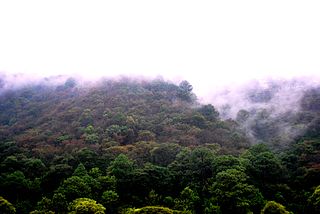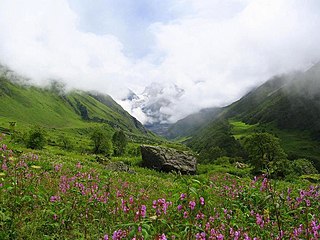Related Research Articles

The ecology of California can be understood by dividing the state into a number of ecoregions, which contain distinct ecological communities of plants and animals in a contiguous region. The ecoregions of California can be grouped into four major groups: desert ecoregions, Mediterranean ecoregions, forested mountains, and coastal forests.

The Hispaniolan pine forests are a subtropical coniferous forest ecoregion found on the Caribbean island of Hispaniola, which is shared by Haiti and the Dominican Republic. The ecoregion covers 11,600 km2 (4,500 sq mi), or about 15% of the island. It lies at elevations greater than 800 m (2,600 ft) in the mountains of Hispaniola, extending from the Cordillera Central of the Dominican Republic and into the Massif du Nord of Haiti. It is surrounded at lower elevations by the Hispaniolan moist forests and Hispaniolan dry forests ecoregions, which cover the remainder of the island. Annual rainfall is 1,000–2,000 mm (39–79 in).

The Kazakh Steppe, also called the Great Dala, is a vast region of open grassland in northern Kazakhstan and adjacent portions of Russia. It lies east of the Pontic steppe and west of the Emin Valley steppe, with which it forms part of the Eurasian steppe. The Kazakh Steppe is an ecoregion of the temperate grasslands, savannas, and shrublands biome in the Palearctic realm. Before the mid-nineteenth century it was called the Kirghiz steppe, 'Kirghiz' being an old Russian word for the Kazakhs.

The Sierra de Juárez, also known as the Sierra Juarez, is a mountain range located in Tecate Municipality and northern Ensenada Municipality, within northern Baja California state of northwestern Mexico.

The Emin Valley is located on the China–Kazakhstan border, in Central Asia. It has an area of about 65,000 square kilometres (25,000 sq mi). Its main waterway is the Emil River.

The Scandinavian montane birch forests and grasslands is a tundra ecoregion in Norway, Sweden, and Finland. It is one of the terrestrial ecoregions determined and defined by the World Wildlife Fund.

The Eastern Mediterranean conifer-sclerophyllous-broadleaf forests, also known as the Eastern Mediterranean conifer-broadleaf forests, is an ecoregion in the eastern Mediterranean Basin. It covers portions of Turkey, Syria, Lebanon, Israel, Palestinian territories, Jordan, and Saudi Arabia.

The Central American pine–oak forests ecoregion, in the tropical and subtropical coniferous forests biome, is found in Central America and Chiapas state of southern Mexico.

The Western Himalayan alpine shrub and meadows is a montane grasslands and shrublands ecoregion of Nepal, India, and Tibet, which lies between the tree line and snow line in the western portion of the Himalaya Range.

The Eastern Himalayan alpine shrub and meadows is a montane grasslands and shrublands ecoregion of Bhutan, China, India, Myanmar, and Nepal, which lies between the tree line and snow line in the eastern portion of the Himalaya Range.

The Northern Triangle temperate forests is a temperate broadleaf and mixed forest ecoregion of thick forest covering the mountains of northern Myanmar.

The Taiheiyo evergreen forests is a temperate broadleaf forest ecoregion of Japan.

The Honshū alpine conifer forests ecoregion covers 4,400 square miles (11,000 km2) in the high-elevation mountains of central Honshū and the Oshima Peninsula of Hokkaidō, Japan. It is a temperate coniferous forest ecoregion in the Palearctic realm.

The East African montane forests is a montane tropical moist forest ecoregion of eastern Africa. The ecoregion comprises several separate areas above 2000 meters in the mountains of South Sudan, Uganda, Kenya, and Tanzania.
The ecology of the Himalayas varies with climate, rainfall, altitude, and soils. The climate ranges from tropical at the base of the mountains to permanent ice and snow at the highest elevations. The amount of yearly rainfall increases from west to east along the southern front of the range. This diversity of climate, altitude, rainfall and soil conditions supports a variety of distinct plant and animal species, such as the Nepal gray langur

The Central American montane forests are an ecoregion of the tropical and subtropical moist broadleaf forests biome, as defined by the World Wildlife Fund, located in mountains of Central America.
References
- ↑ World Wildlife Fund, ed. (2001). "Himalayan subtropical pine forests". WildWorld Ecoregion Profile. National Geographic Society. Archived from the original on 2010-03-08.
- ↑ World Wildlife Fund, ed. (2001). "Western Himalayan broadleaf forests". WildWorld Ecoregion Profile. National Geographic Society. Archived from the original on 2010-03-08.
- ↑ World Wildlife Fund, ed. (2001). "Western Himalayan subalpine conifer forests". WildWorld Ecoregion Profile. National Geographic Society. Archived from the original on 2010-03-08.
- ↑ World Wildlife Fund, ed. (2001). "Rann of Kutch seasonal salt marsh". WildWorld Ecoregion Profile. National Geographic Society. Archived from the original on 2010-03-08.
- ↑ World Wildlife Fund, ed. (2001). "Indus Valley desert". WildWorld Ecoregion Profile. National Geographic Society. Archived from the original on 2010-03-08.
- ↑ World Wildlife Fund, ed. (2001). "Thar desert". WildWorld Ecoregion Profile. National Geographic Society. Archived from the original on 2010-03-08.
- ↑ World Wildlife Fund, ed. (2001). "Indus River Delta-Arabian Sea mangroves". WildWorld Ecoregion Profile. National Geographic Society. Archived from the original on 2010-03-08.
- ↑ World Wildlife Fund, ed. (2001). "East Afghan montane conifer forests". WildWorld Ecoregion Profile. National Geographic Society. Archived from the original on 2010-03-08.
- ↑ World Wildlife Fund, ed. (2001). "Karakoram-West Tibetan Plateau alpine steppe". WildWorld Ecoregion Profile. National Geographic Society. Archived from the original on 2010-03-08.
- ↑ World Wildlife Fund, ed. (2001). "Kuhrud-Kohbanan Mountains forest steppe". WildWorld Ecoregion Profile. National Geographic Society. Archived from the original on 2010-03-08.
- ↑ World Wildlife Fund, ed. (2001). "Northwestern Himalayan alpine shrub and meadows". WildWorld Ecoregion Profile. National Geographic Society. Archived from the original on 2010-03-08.
- ↑ World Wildlife Fund, ed. (2001). "Tian Shan montane steppe and meadows". WildWorld Ecoregion Profile. National Geographic Society. Archived from the original on 2010-03-08.
- ↑ World Wildlife Fund, ed. (2001). "Baluchistan xeric woodlands". WildWorld Ecoregion Profile. National Geographic Society. Archived from the original on 2010-03-08.
- ↑ World Wildlife Fund, ed. (2001). "Registan-North Pakistan sandy desert". WildWorld Ecoregion Profile. National Geographic Society. Archived from the original on 2010-03-08.